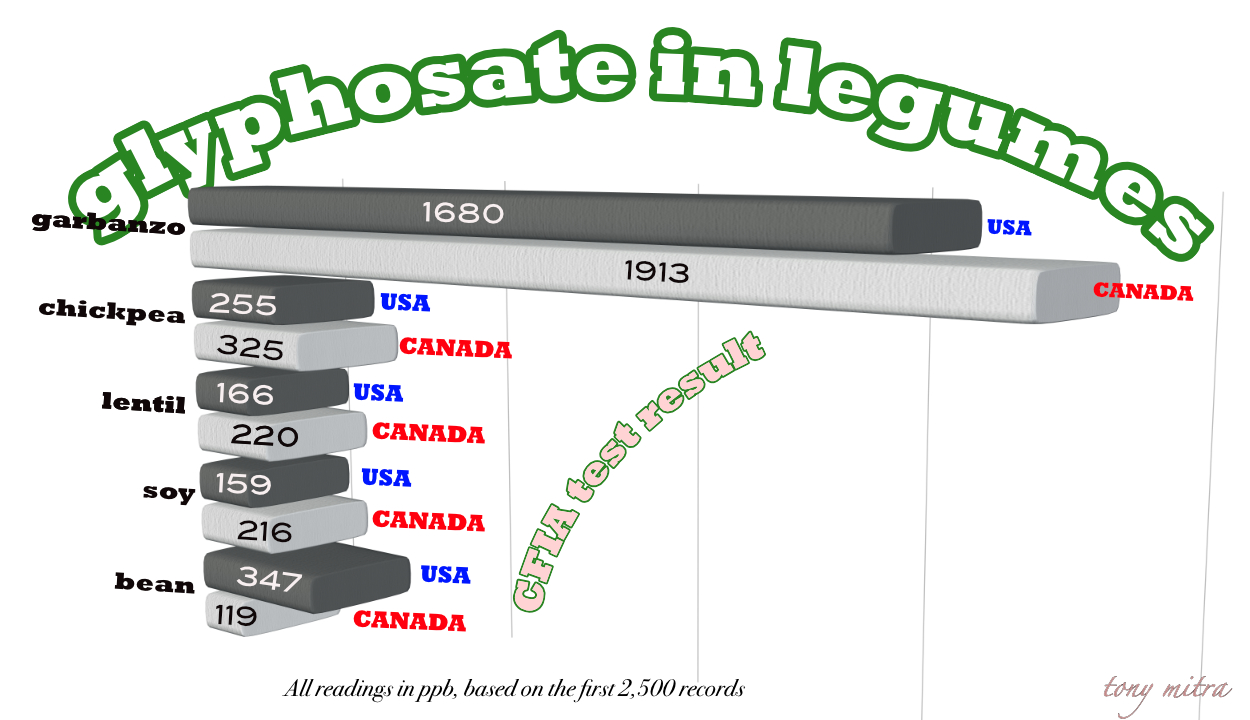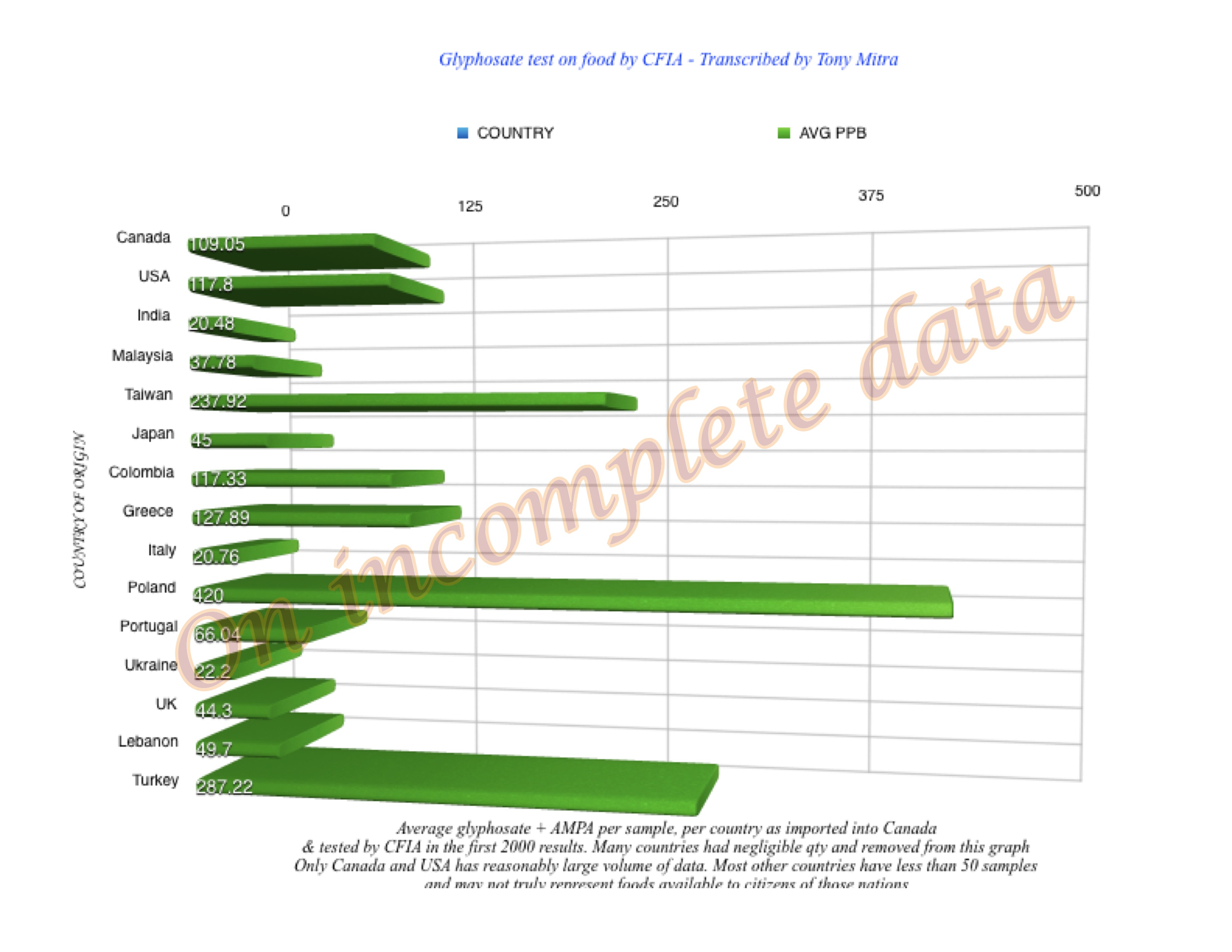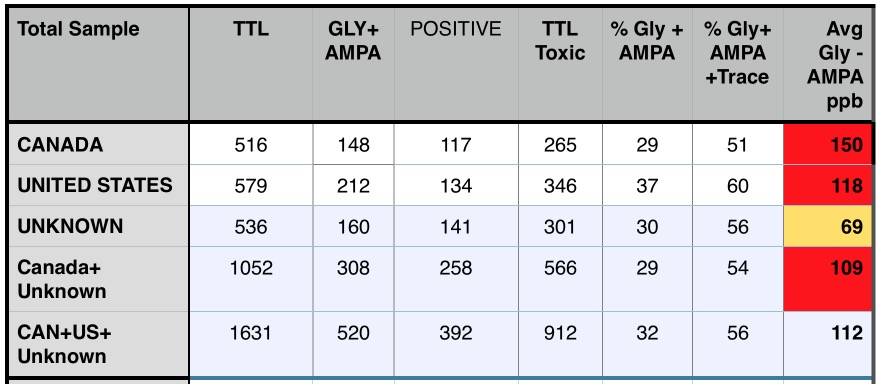
Glyphosate content in ppb.
Above chart with partial data (2,000 test results out of over 7,000 from CFIA so far looked at) is for buckwheat only. For those who like to eat buckwheat for health or other reasons, but do not like to have glyphosate with it, may consider a few options – consider buying buckwheat from China or Russia and avoid the other sources, or alternately go organic.

Glyphosate contamination in ppb in legumes produced in Canada and US (out of the first 2,500 records)
And above is the chart for legumes produced in just two countries. Samples of legumes tested elsewhere gives a different story. Some countries have far less glyphosate in them, but only a few samples tested. Some countries have very high glyphosate figures in some categories but not others, also with low sample number. Canada and USA stand out as particular bad example for legumes with regard to glyphosate contamination, and garbanzo is the worst.
There is so much data to go through, covering the CFIA test of foods collected in Canada for glyphosate content, that analyzing it meaningfully is a task that demands attention and also an effort to look at it from different angles and present views that might be easier to understand.
I wonder if I might some day have a book on the topic of glyphosate in food as collected in Canada. Some of the details are revealing, while absence of some foods from test is equally galling. Therefore there is likely a need for some effort that fills the gaps. Getting Municipalities to start testing foods is believed to be an excellent opportunity to fill the blanks.
And, here are a few charts from the data so far transcribed, about the CFIA test records.

This is a partial country breakdown, after transcribing 2,000 records. Some countries have low sample numbers so their indications may not be true representation. Canada & USA have high sampling numbers.
And then the table below. Food samples marked as Canadian are turning out less than American foods. I find that hard to believe when samples are being drawn from al corners of Canada. Equally puzzling is the largest chunk of the samples coming under “unknown” origin. I suspect these unknown foods are unlabelled bulk foods picked up from local stores all over the country, and are likely to be more of Canadian origin than any other. Also that makes the Canadian sample count to be almost twice as many as US samples. So I created a row with the combined Canada+Unknown items, and consider that to be a better representation of Canadian foods. This also brings the average glyphosate (and AMPA) count o the foods from Canada and USA closer to each other, which seems logicals since both have similar agricultural practices and Canada is so heavily (and in my view negatively) influenced by American agro-industrial influence.
The table below gives some of the basics.

One kind of presumably healthy food category that has really surprised me with astonishingly high glyphosate content – is gluten free food. So much so that I had to try and separate them from the rest and see how the figures play out.
Out of the first two thousand odd records, I find very very few gluten free items from any country except USA and Canada, so I ignored them and focussed on just these two. USA has 130 samples and Canada 99, that have “gluten free” in their description. Average glyphosate + AMPA readings for the US produced gluten free product is 248 ppb and that for Canada is 286.
These readings are between two and three times the national average for USA and Canada, which are already hight to start with. Somehow, anything that has “gluten free” mentioned has become suspect- in my mind.
This is but a preliminary report. I shall later check if Organic-Gluten free is any better, and if it is any better than standard, non-organic, non-glutens free, off the shelf conventional food.

Gluten Free foods have been among the most baffling due to high glyphosate concentration.
But when you break it down to organic and non-organic of the gluten free foods produced in USA and Canada, the pictures changes dramatically, as below.

Non-organic gluten free stuff is way worse than national averages, and out of the two, the Canadian product sucks more
The confusion regarding Organic stamp and gluten free food
If you go to my blog, and download the initial 803 records, in searchable pdf, you can check each record that has the words “gluten free” and see the test results and what kind of food.
There still will be a problem. CFIA has removed the label and the true description of the source of the food sample.
So, if you find ten cases of gluten free flour of some kind, and see that nine out of those ten are having high glyphosate and only one is clean, it might be impossible to ascertain which specific brand, or store or place one must to to pick up the clean variety and not the nine dirty types. This is one reason I would say that gluten free this or that item is in general suspect, because the average glyphosate content (adding the glyphosate amount of the nine positive samples and dividing by ten total samples) gives a pretty high glyphosate parts per billion figure and chance of me getting a good doze of it from this item is high.
For those that are gluten intolerant, the problem is amplified and becomes circular. eating high glyphosate gluten free food on one side removes the pair or discomfort of taking in gluten, on the other side perhaps ensure that the gluten intolerance (it is now more or less established that gut bacteria damage is one of the root causes of gluten intolerance, and that glyphosate hurts gut bacteria) problem is likely to continue or worsen instead of get better, because of continued intake of more glyphosate.
It just so happens that “Organic” gluten free food, in general, are a lot cleaner than conventional gluten free food.
One could download the pdf file and check it for any kind of permutation and combination to arrive at suitable decisions that address one’s particular need.
As and when more data is transcribed, cross checked and error-corrected, more of it will be published on line.
Time to time I take a break and make a chart or two to address some things that appear puzzling or surprising to me.
Finding glyphosate content so much higher in gluten free food that the general average of all foods, came as a surprise since I used to think of gluten free as a healthier kind of food. I personally do not buy gluten free, do not have allergy to gluten and do understand that keeping my gut bacteria healthy has gotten to be very important for my immune system and general health.
We are living in a very difficult world, where the US and Canadian Government is constantly changing definitions of food stamps. Today they accept certain kind of contamination even within certified organic label and has invented multiple kinds of USDA-Organic stamp, with different colours accepting different percentage of the food to have non-organic content.
For example, I just learned from a scientist in USA that the “green label” USDA organic stamp allows 5% non-organic food to be within it. The black USDA-Organic stamp will allow 30% non-organic content in it and still have that black circular USDA Organic stamp.
I am trying to figure out Canadian Government standards on this. As far as CFIA records go, the foods are only described “organic” without any clarification.
For any that wish to investigate and help us with the general work, you may wish to read through the Canadian Safe Food (read Organic) regulation standard for 2017 and see if the Canadian Government is also following the US counterpart in allowing various levels of impurity into the food and yet agreeing to stamp it with different flavours of the circular “CANADIAN ORGANIC – BIOLOGIQUE CANADA”stamp. Click on the image below for the full pdf document and download for your study.
Some text here might appear long winded or a bit out of context. That is because I am aiming to eventually prepare a book or an e-book on the topic and am using some of these blogs as a store of some of my off the cuff write-ups.
I know the pro-Monsanto and pro-glyphosate lobby will snigger and pass condescending notes that the amounts mentioned are tiny, irrelevant and is not harmful to humans, based on yada yada yada reports.
But this blog, or my efforts, are not to engage in any argument with these characters. To me, no amount of glyphosate is desirable, because:
- Safety test records and data, based on which Health Canada approved glyphosate, is still kept hidden from the people, illegally I might add, and I am having a multi-year long battle to get them to disclose the data, without which I am unprepared to listen to these industry cronies.
- Science has been hijacked by industry. We need science funding to be taken away from industry, restriction removed so that Universities can test for both good points as well as potential dangers of glyphosate, without any interference from promoters, and let all the findings be part of the body of science. Let chips fall as they may. Let twenty years pass and enough material be collected to highlight both sides of the argument. Only then am I willing to even consider listening to reports or evaluations of the scientific community, on safety of glyphosate.
- Let someone prove Anthony Samsel and Stephanie Seneff wrong by showing that glyphosate is NOT an analog (mimic) of glycine and it does NOT get picked up by our biology into the extra-cellular matrix, does NOT get into our cells, does NOT get used by our RNA to produce peptides or peptides which eventually end up as new proteins where glyphosate replaces glycine with disastrous consequence to the function of the protein. If such a proof is not produced, I am prepared to ignore all comments on mere toxicological tests and studies on safety of glyphosate.
Meanwhile, I intend to analyze the CFIA test record data with my own assumption that the only safe limit for glyphosate is ZERO, irrespective of what guideline CFIA, Health Canada, EPA or anybody else follows. This analysis is based on that assumption. Those that follow my reasoning, they may continue to read them Those that do not believe my reasoning – go someplace else. I have no time nor any inclination, to argue with you all. Just go.
Lentils and Chickpea/ Garbanzo beans
These have been a nightmare – since these readings are so high, often going into several thousand ppb (parts per billion – which is derived by multiplying the ppm or µg/g figures by CFIA) on some of the samples. I shall address those items later on on this blog. Meanwhile, I prepared some charts for India, since lentil is a heavily consumed group of seeds in India and since this is increasingly popular in the west and since North America is beginning to produce a lot of it, perhaps hoping to re-export back to India where production is falling behind rising demand.

Indian lentils seem to have rising amount of glyphosate, but nowhere as high as lentils produced in Canada (not shown in this chart)
The chart below shows, among all the foods imported from India into Canada, nearly seventy such samples so far seen out of 2,000 odd records, the worst group is the lentil + Chickpea group, compared to say, rice, or any other item.
Canadian grown lentils are way worse than the Indian grown. I shall show them later. Meanwhile, here is another chart about India, or rather, about the foods imported from India into Canada and tested by CFIA. Its the percentages of samples that contain glyphosate/AMPA.

Percentage of bad food among imported Indian samples. You may click on the image to get to the pdf file of the 800 odd records so far transcribed and put on line.
The above chart means, out of all the lentils imported from India, 50% are having glyphosate. Over 12% of the rice has glyphosate, though mostly trace amount, and among the rest – which include a whole gamut from pickles to snacks, over 71% have some glyphosate. However, the averages as you can see in the previous chart above, are still low compared to foods grown in North America.
I shall come back with more shortly. I am also trying out various chart types to practice on them, for perhaps putting in an e-book I might publish on Amazon kindle, about glyphosate in food.
General North American Food
Since readings between USA and Canadian food samples appear more or less similar when compared to foods imported from anywhere else, I have also combined to two for a general idea of glyphosate contamination in certain categories that appear to have high glyphosate contamination, without separating organic from non-organic labelling. The graph below shows that.

Suspect categories of North American food with regard to glyphosate contamination.
More later.

